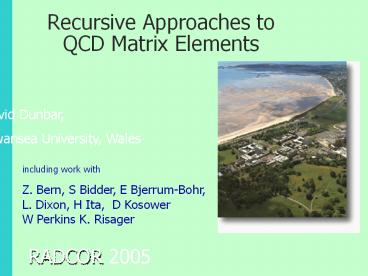Recursive Approaches to QCD Matrix Elements - PowerPoint PPT Presentation
Title:
Recursive Approaches to QCD Matrix Elements
Description:
QCD matrix elements are an important part of calculating the QCD background for ... Four Point : Ellis Sexton -Five Point : Bern, Dixon,Kosower ... – PowerPoint PPT presentation
Number of Views:35
Avg rating:3.0/5.0
Title: Recursive Approaches to QCD Matrix Elements
1
Recursive Approaches to QCD Matrix Elements
David Dunbar, Swansea University, Wales
including work with Z. Bern, S Bidder, E
Bjerrum-Bohr, L. Dixon, H Ita, D Kosower
W Perkins K. Risager
RADCOR 2005
2
QCD Matrix Elements
- -QCD matrix elements are an important part of
calculating the QCD background for processes at
LHC - -NLO calculations (at least!) are needed for
precision - -One-Loop n-point on-shell amplitudes unknown for
ngt5 - -In this talk we discuss how recent (gt Dec 03)
ideas of a weak-weak duality might help, - - apply to 2g ? 4g
2 ? 4 talks of Binoth,Dittmaier
3
Duality with String Theory
- In Dec 03 Witten proposed a Weak-Weak duality
between - A) Yang-Mills theory ( N4 )
- B) Topological String Theory
S-matrix of two theories should be identical
-True for tree level gluon scattering
Rioban, Spradlin,Volovich
proposal constructive for N4 but Nlt4..??
4
Duality Details
- Amplitude a function
- Spinor helicity replaces polarisation by
fermionic variables - Use fermionic coordinates and replace bosonic
momenta by twistors - Amplitude now function entirely of fermionic
variables - Fourier (Penrose transform) one of spinors,
- Amplitude in twistor space is closest to string
theory
Xu, Zhang,Chang 87
5
Is the duality useful?
Theory A hard, interesting
Theory B easy
Topological String Theory harder, uninteresting
Perturbative QCD, hard, interesting
-duality may be useful indirectly
6
Inspired by duality the CSW/MHV-vertex
construction
Cachazo Svercek Witten 04, (Nair)
Parke-Taylor, Berends-Giele
(colour ordered amplitudes)
- Promotes MHV amplitude to fundamental object by
- -Off-shell continuation
- -makes YM perturbative expansion match that of
B-instantons
7
_
_
_
_
_
_
_
_
-three point vertices allowed
-number of vertices (number of -) -1
8
MHV-vertex construction
- Works for gluon scattering tree amplitudes
- Works for (massless) quarks
- Works for Higgs and Ws
- Works for photons
- Works for gravity
Wu,Zhu Su,Wu Georgiou Khoze
Badger, Dixon, Glover, Forde, Khoze, Kosower
Mastrolia
OzerenStirling
Bjerrum-Bohr,DCD,Ita,Perkins, Risager
-Works for one-loops in
SUPERSYMMETRIC theories -In trouble for
non-SUSY theories
Bedford,Brandhuber, Spence and Travaglini
Qigley,Rozali
A()
9
Inspired by duality BCFW construction for tree
amplitudes
Britto,Cachazo,Feng (and Witten)
- Return of the analytic S-matrix!
- Shift amplitude so it is a complex function of z
Amplitude becomes an analytic function of z, A(z)
Full amplitude can be reconstructed from analytic
properties
10
Provided,
then
Residues occur when amplitude factorises on
multiparticle pole (including two-particles)
11
-results in recursive on-shell relation
(three-point amplitudes must be included)
12
CSW vs BCF
- Difference
- CSW asymmetric between helicity sign
- BCF chooses two special legs
- Similarities-
- both rely upon analytic structure
CSW can be derived from a type of analytic shift
Risager Bjerrum-Bohr,Dunbar,Ita,Perkins and
Risager, 05
13
One-Loop Amplitudes
- One Loop Gluon Scattering Amplitudes in QCD
- -Four Point EllisSexton
- -Five Point Bern, Dixon,Kosower
- -Six-Point and beyond--- present problem
n-point MHV amplitudes supersymmetric theories
Six-point N4 amplitudes
Bern,Dixon,Dunbar and Kosower 94/95
14
Supersymmetric Decomposition
Supersymmetric gluon scattering amplitudes are
the linear combination of QCD onesscalar loop
-this can be inverted
15
N4 One-Loop Amplitudes solved!
- Amplitude is a a sum of scalar box functions with
rational coefficients (BDDK,1994) - Coefficients are cut-constructable
(BDDK,1994) - .
- .
- Quadruple cuts turns calculus into algebra
(Britto,Cachazo,Feng,2005) - Box Coefficients are actually coefficients of
terms like
16
Box-Coefficients
Britto,Cachazo,Feng
S
-works for massless corners (complex momenta)
or signature (--)
-works for non-supersymmetric
Bjerrum-Bohr,Bidder,DCD,Perkins
17
N1 One-Loop Amplitudes -????
- Important to choose a good basis of functions
- A) choose chiral multiplet
- B) use D6 boxes
- Amplitude also cut constructible
- -six gluon amplitudes now obtained using unitarity
Bidder,Bjerrum-Bohr,Dixon, Dunbar, Perkins
Britto, Buchbinder Cachazo, Feng, 04/05
18
The Final Pieces scalar contributions
-last component of QCD amplitudes
- R is rational and not cut constructible (to
O(?))
-can we avoid direct integration?
19
Recursion for Rational terms
-can we shift R and obtain it from its
factorisation?
- Function must be rational
- Function must have simple poles
- We must understand these poles
20
-understanding poles
-multiparticle factorisation theorems
Bern,Chalmers
21
Complication,
Either R or the coefficients of integral
functions may contain Spurious Singularities
which are not present in the full amplitude
It is important and non-trivial to find shift(s)
which avoid these spurious singularities whilst
still affecting the full R/coefficient
22
Example of Spurious singularities
23
Spurious singularities spoil understanding of
residues can we avoid them?
Splitting Amplitude into C and R is not unique
The integral functions can be defined to include
rational pieces, e.g
rather than
avoids a spurious singularity as r?1 (rs/s)
24
Results
It has been demonstrated, using A) (-.),
(.) and B) (--) and (--.)
1)
that shifts can be found which allow calculation
of rational parts recursively
Bern, Dixon Kosower
Forde, Kosower
Shifts can be found which allow the integral
coefficients to be computed recursively
2)
A(---..--)
Bern, Bjerrum-Bohr, Dunbar, Ita
25
State of Play Six Gluon Scattering
2g-? 4g
X
X
X
X
X
X
X
X
X
X
X
X
X
X
X
X
X
26
Conclusions
- -Reasons for optimism in computing one-loop QCD
matrix elements - -Recent progress uses UNITARITY and FACTORISATION
as key features of on-shell amplitudes - -Inspired by Weak-Weak duality but not dependant
upon it - -after much progress in highly super-symmetric
theories the (harder) problem of QCD beginning to
yield results - -first complete result for a partial 2g ? ng
amplitude!
-also fermions, masses, multiloop..???.......































